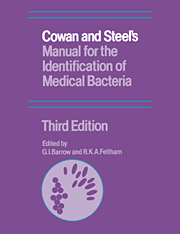Book contents
- Frontmatter
- Contents
- Foreword
- Preface to the first edition
- Postscript
- Preface to the second edition
- Preface to the third edition
- List of contributors
- Introduction
- 1 Classification and nomenclature
- 2 Culture media: constituents and sterilization
- 3 Principles of isolation
- 4 Bacterial characters and characterization
- 5 Theory and practice of bacterial identification
- 6 Characters of Gram-positive bacteria
- 7 Characters of Gram-negative bacteria
- 8 Taxonomy in theory and practice
- 9 Bacterial identification by cards
- 10 Bacterial identification by computer
- 11 Quality control in microbiology
- Appendices
- References
- Index
10 - Bacterial identification by computer
Published online by Cambridge University Press: 15 December 2009
- Frontmatter
- Contents
- Foreword
- Preface to the first edition
- Postscript
- Preface to the second edition
- Preface to the third edition
- List of contributors
- Introduction
- 1 Classification and nomenclature
- 2 Culture media: constituents and sterilization
- 3 Principles of isolation
- 4 Bacterial characters and characterization
- 5 Theory and practice of bacterial identification
- 6 Characters of Gram-positive bacteria
- 7 Characters of Gram-negative bacteria
- 8 Taxonomy in theory and practice
- 9 Bacterial identification by cards
- 10 Bacterial identification by computer
- 11 Quality control in microbiology
- Appendices
- References
- Index
Summary
In 1968, Dybowski & Franklin suggested various theoretical models for using computers to help with the identification of bacteria, but the first practical systems for computer-assisted identification were not introduced until 1973 by Friedman et al. and Lapage et al.. They depended on a full set of standardized routine tests carried out under strict laboratory control. One such system for strains difficult to identify in diagnostic laboratories has been perpetuated in the Identification Services Laboratory in the National Collection of Type Cultures (NCTC) at Colindale, London. The work of this laboratory was extensively reviewed by Willcox, Lapage & Holmes (1980). Other national culture collections have set up similar services for their own countries. The ranges of the tests applied have increased progressively in order to accommodate new species and genera. Bacterial groups which have been updated recently or examined in this way include the aerobic fermenting and non-fermenting Gram-negative rods (Holmes & Dawson, 1983; Holmes, Pinning & Dawson, 1986), the Gram-positive aerobic cocci (Feltham & Sneath, 1982) and the genus Bacillus (Logan & Berkeley, 1984). Other bacterial groups have been investigated elsewhere.
Commercial kit suppliers have constructed large databases for their particular range of tests and organisms. As with the Tables in this Manual, the test reactions for identification databases or matrices have often been compiled from a variety of sources. The tables or matrices consist of columns usually showing the percentage of positive test reactions, each row representing a cluster or group of similar organisms.
- Type
- Chapter
- Information
- Publisher: Cambridge University PressPrint publication year: 1993

